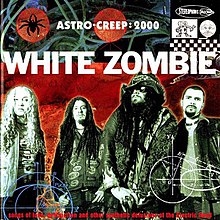Astro Creep 2000
| Astro-Creep: 2000 | ||||
|---|---|---|---|---|
 |
||||
| Studio album by White Zombie | ||||
| Released | April 11, 1995 | |||
| Recorded | 1994 | |||
| Studio | NRG Studios (Los Angeles, CA) |
|||
| Genre | Industrial metal, groove metal, alternative metal | |||
| Length | 52:01 | |||
| Label | Geffen | |||
| Producer | Terry Date | |||
| White Zombie chronology | ||||
|
||||
| Singles from Astro-Creep: 2000 | ||||
|
||||
| Professional ratings | |
|---|---|
| Review scores | |
| Source | Rating |
| AllMusic | |
| Robert Christgau | |
| Entertainment Weekly | (B+) |
| Q | |
| Rolling Stone | |
Astro-Creep: 2000 – Songs of Love, Destruction and Other Synthetic Delusions of the Electric Head (or simply Astro-Creep: 2000) is the fourth and final studio album by White Zombie, released on April 11, 1995 by Geffen Records. The album proved to be their most commercially successful recording, peaking at number six on the Billboard 200 with the aid of the popular hit singles "More Human than Human" and "Super-Charger Heaven". It was the band's only album to feature John Tempesta on drums.
The album was highly anticipated due to the surprise success of the band's previous release La Sexorcisto: Devil Music Volume One. Ivan DePrume, the drummer on La Sexorcisto, had left the band to start Burningsound studios during their touring sessions for that album. The band later recruited former Exodus and Testament drummer John Tempesta for the recording of this album. The album had help from significant industrial musicians, such as the keyboard work from Charlie Clouser, who had worked with artists like Nine Inch Nails, Rammstein, Marilyn Manson, Killing Joke, and more. They had also hired Terry Date (Deftones, Pantera, Soundgarden) to produce Astro-Creep: 2000 for them. According to J., the album comprises seventy-two track recordings, forty-eight of which are analog and twenty-four being digital recordings. The entire album took three months to write and another three to record. For the album, the band had a much bigger recording budget and more freedom in time.
...
Wikipedia
